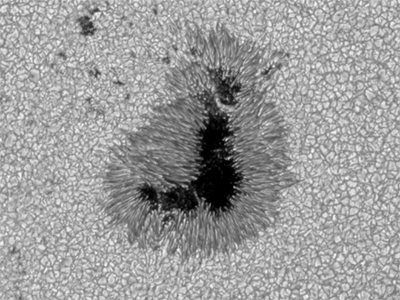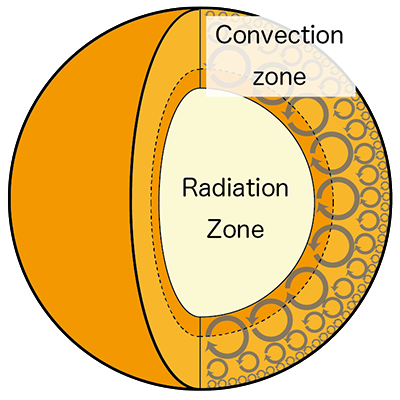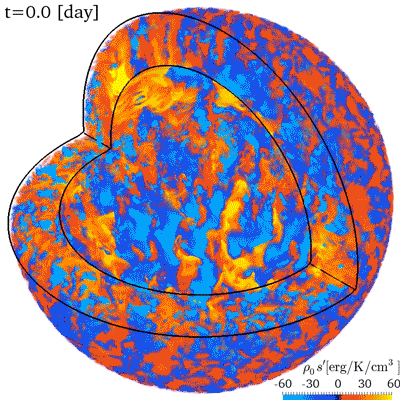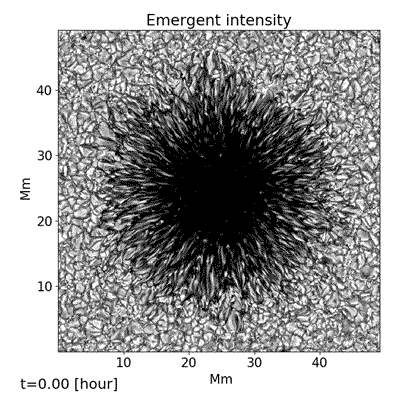Associate Professor
Division of Plasma Astrophysics

The closest star to Earth is the Sun. It provides our planet with constant illumination, but in fact, it is extremely active and still full of mystery. The most important element of solar activity is sunspots. (See Figure 1.)
Sunspots are regions on the solar surface where the magnetic field is very strong, and that strong magnetic field is responsible for the largest explosive events in the current solar System: solar flares and coronal mass ejections.

The most puzzling aspect of sunspots is their 11-year cycle. The first scientific observations of sunspots began when Galileo Galilei observed them with a telescope in the early 1600s. For most of the 400 years since then, the number of sunspots has fluctuated following the 11-year-long cycle. (See Figure 2.)
The physical mechanism for the 11-year cycle is yet unknown. Sunspots correspond to a strong magnetic region on the solar surface, so we can interpret the sunspot cycle as being connected to the cycle of magnetic field fluctuations. Therefore, the mystery behind the 11-year cycle can be thought of as the mystery behind the generation and maintenance of the solar magnetic field. The solar magnetic field is thought to be generated in the solar interior, but we cannot see the inside of the Sun using any wavelength of light. (That being said, we can get a general idea about the region around the center of the Sun using neutrinos.) That is why we use numerical simulations to model the solar interior and solve the mystery of the 11-year sunspot cycle.

Let us give you a brief summary of what the interior of the Sun looks like. Our Sun continuously produces energy in its core through nuclear fusion. (This is unrelated to the current topic of discussion, but neutrinos generated during the fusion process can be observed on Earth.) The energy produced in the core is transferred out of the Sun by means of radiation until a distance about 70% of the way from the center to the surface. However, the opacity of the Sun increases at that point, so radiative transfer efficiency drops, and energy starts to be transferred by means of convection – the same process we see when boiling water. The Sun is primarily composed of hydrogen and helium, but due to the extreme heat of the solar interior, the electrons and protons that make up the hydrogen and helium are separated into a state called plasma. Since the plasma and the magnetic field move together (i.e. the field lines are “frozen in” to the plasma), when the plasma is subjected to turbulent thermal convection, the magnetic field becomes stretched by that motion. The more the magnetic field is stretched, the more energy it holds. It is thought that this is the fundamental mechanism by which the magnetic field is generated in the solar interior. (See Figure 3.)
If this were the entire story, it would be simple, but due to the enormous size and low viscosity of the Sun, thermal convection inside the Sun is thought to have a structure that is both complex and turbulent. For example, classically, it is thought that the convection zone extends down to a depth 200,000 km from the surface, but the smallest scale at which viscosity holds within the Sun is around 1 cm, so it is very difficult to understand the processes by which such a complex turbulent flow could produce a magnetic field.
This is where numerical simulation can play an important role, but even using numerical simulation, it is difficult to model such high levels of turbulence. A numerical simulation that models the interior of the Sun divides the space within into grids and solves differential equations for each. The smaller we define the elements of that grid, the more accurate the model becomes, but accordingly, the computational cost also increases. That is why it is necessary to make effective use of supercomputers like K-computer or Fugaku to accurately model the solar interior. Japanese researchers are lucky to have access to a relative abundance of supercomputer computational resources, and if we can use them effectively, we could lead the world in this type of research. However, it is not an easy task to use massive systems like K-computer and Fugaku efficiently. In order to do so, our group has reviewed various computational methods and developed our own codes that enable us to perform some of the most advanced calculations currently being performed anywhere in the world.

The results of our work can be seen in Figure 4 above.
Figure 4 is a model of the solar turbulent flow and magnetic field calculated with few conditions and considering the Sun as a whole. Precise observations have revealed the amount of radiation the Sun emits, its internal density, pressure, temperature distribution and other properties, so it is possible to reduce the number of assumptions included when performing calculations. Efforts like this have helped make it gradually clearer that the large-scale magnetic field within the Sun has periodicity. It is known that periodicity can arise from the stretching of the field due to large-scale flow in the solar interior and from the slight regularity in turbulence affected by rotation, but the question remains. Why is that period 11 years long? We hope to answer that question using Fugaku and the next generation of supercomputers.

One obstacle to understanding the 11-year solar cycle is the connection between sunspots and the large-scale magnetic field in the solar interior. It is thought there is some sort of trigger that causes the magnetic field generated within the Sun to emerge from its surface and form sunspots. However, the temporal and spatial scales in the interior and on the surface are significantly different, which makes it difficult to include them both within a single model. Nevertheless, we have developed the method of calculating such a model with numerical simulation code that allows us to solve for both the solar interior and the surface for the first time in the world. Using this code, we can solve for the regions deep within the Sun at the same time as we can obtain precise sunspot models like that in Figure 5. As of 2020, we are the only group who has succeeded in this effort. We hope to continue developing this work to solve the biggest question in solar physics – the mystery behind the 11-year solar cycle.